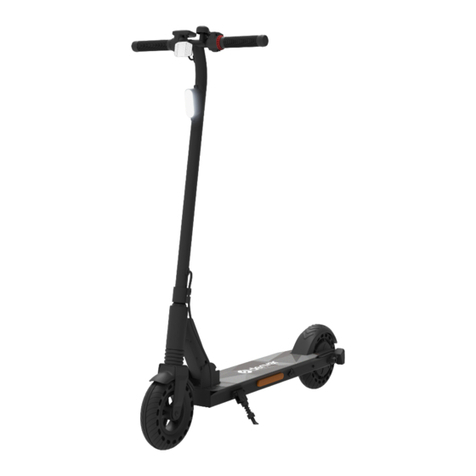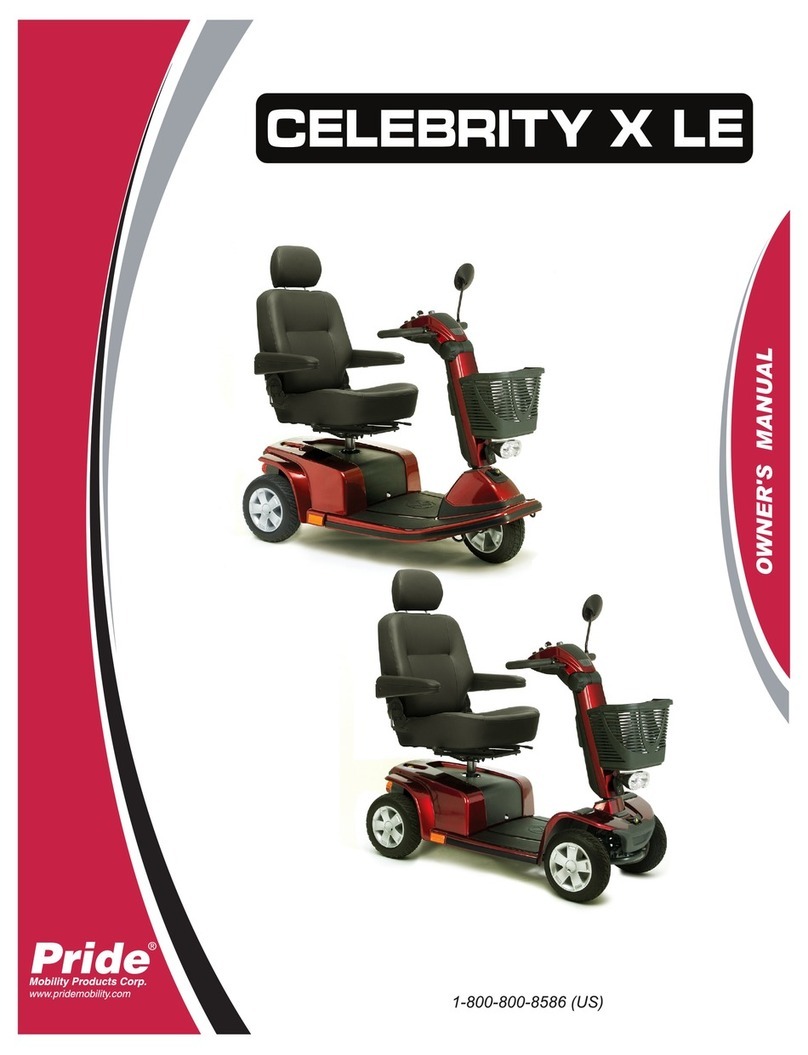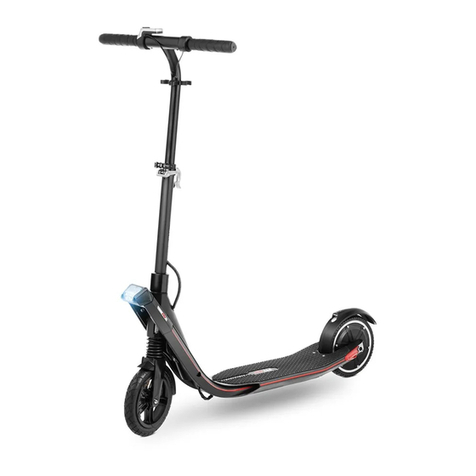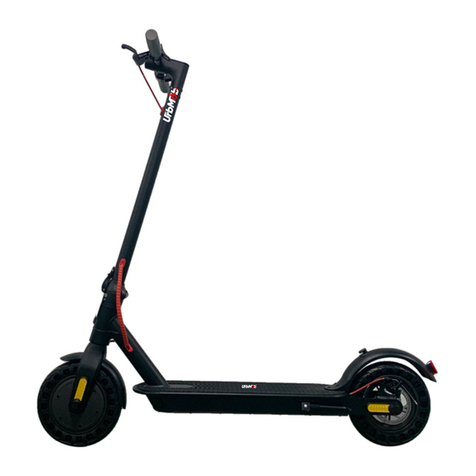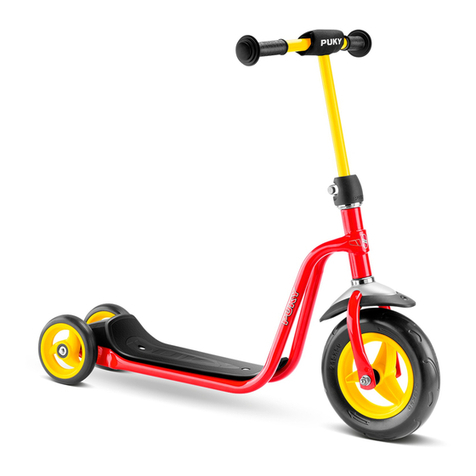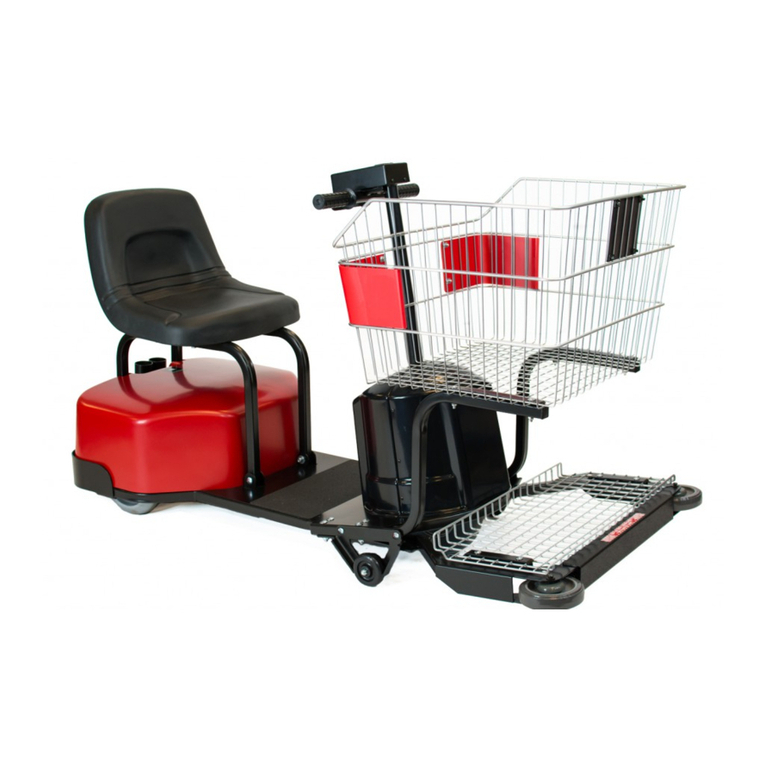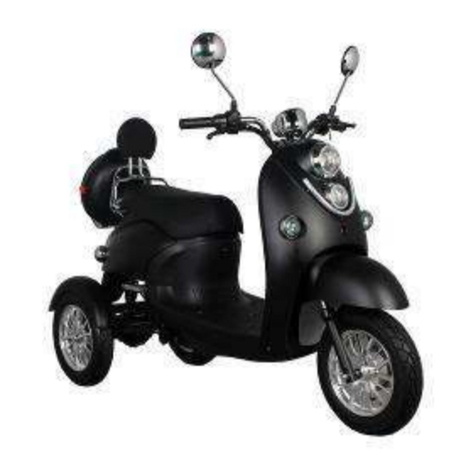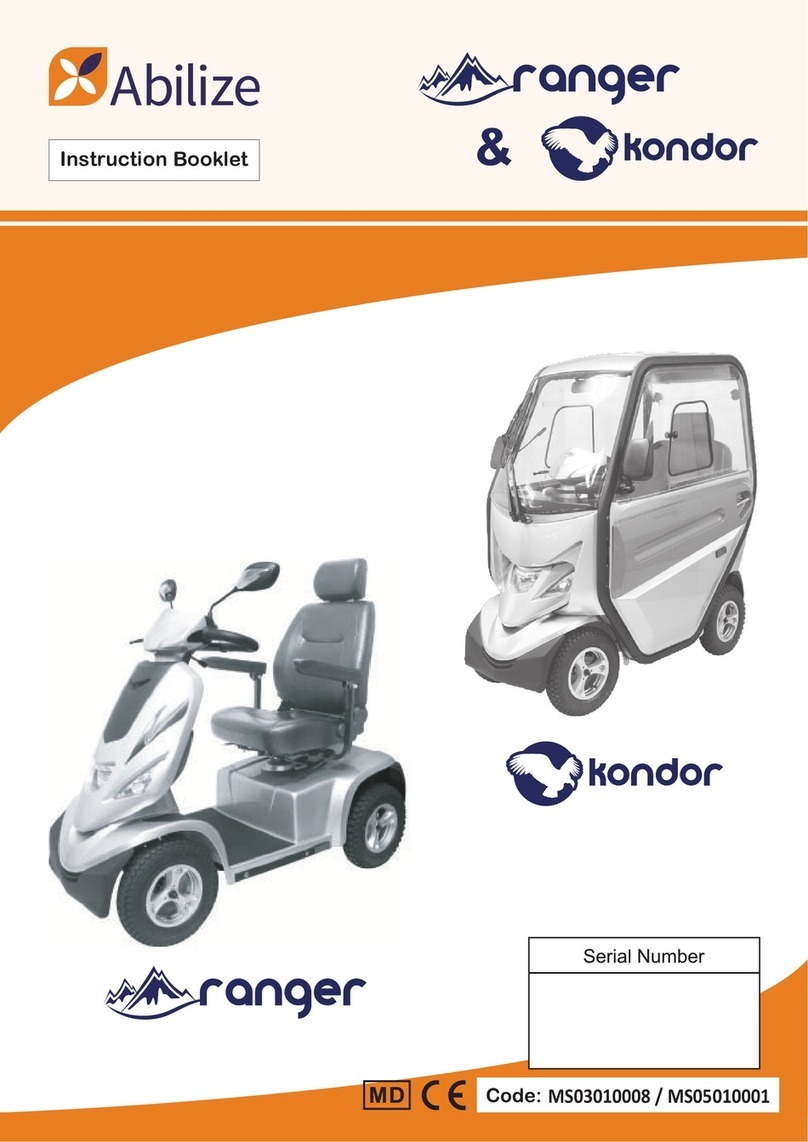Glide Cruisers Calisto User manual

Glide Cruisers, USA
P.O. Box 937
Folsom, CA 95763
Phone: 916.817.1570
Toll Free: 866.766.9653
Glide Cruisers, USA
Owner's Manual
For Models: Calisto, Europa & Solaris
V1.1

Glide Cruisers - Owner's Manual
V1.1
Glide Cruisers, USA
P.O. Box 937
Folsom, CA 95763
Phone: 916.817.1570
Toll Free: 866.766.9653
email support:
Digital version of this manual located at
www.glidecruisers.com/manuals
Table of Contents
1. Before You Glide (quick reference) ................. Pg 3
2. Operation & Safety .......................................... Pg 5
3. Cruiser Model Overview .................................. Pg 9
4. Model Specifications ........................................ Pg 10
5. Component Definitions .................................... Pg 11
6. Diagram of Components .................................. Pg 13
7. APM Computer Console ................................... Pg 15
8. General Maintenance ....................................... Pg 19
9. Battery Care & Maintenance ............................ Pg 21
10. Trouble Shooting .............................................. Pg 23
12. Waranty Information......................................... Pg 26
Owner's Info:
Date: ______________________________
Model: ______________________________
Serial #: ______________________________
Color: ______________________________

Glide Cruisers - Owner's Manual
V1.1
Page |3
Congratulations on the purchase of your new Glide Cruiser! Before you
start riding please take a moment to make sure that you understand the
capabilities and limitations of your new ride.
Before You Glide
Check Equipment
Take a quick look at your Glide to make sure that nothing looks out of place.
Although there aren't many things to be concerned with, it is good to have
"peace of mind" before you ride. First thing to verifiy are the tires and brakes.
Make sure that the tires are adequately inflated (45 - 50 PSI) and that the brakes
work properly. Check the front brake by lifting the front tire off the ground,
spinning the tire and clamping the brake lever. For the rear brake (making sure
kickstand is down) spin the tire manually or by using the throttle -- test the rear
brake. Lastly, verify your battery charge and operation of the motor. Simply turn
the key on and check the motor by pressing the thumb throttle (partially down)
to verify movement of the motor. All units are shipped with a full charge and
should be ready to ride. To be sure - feel free to conduct additional charging.
Plan Your Ride
Distance, weather conditions and terrain are all important factors to consider
when riding your Glide. Glide Electric Cruisers are not designed for off-road
terrain unless the trail or road is relatively flat with no obsticals. The Glide frame
has little ground clearance and is designed for low-center of gravity operation.
Ideal riding terrain is paved bicycle lanes or bike trails. Some cities or counties
have regulation preventing operation of electric bikes and scooters on bike
trails. However, most do allow electric scooters - under which the Glide is
classified. Further, the maximum speed for most US cities (regulation) is 20MPH.
Just be aware of your own riding regulations and restrictions. If you would like to
limit the maximum speed of your motorm consider our optional APM console.
Page |4
Depending on which battery you have, your Glide will have variable capabilities
for total distance. Other factors are constant speed, hills, rider weight and
fluctuation of throttle acceleration. If your destination has A/C power and you
are concerned about running low on your charge - we recommend that you
bring your charger and restore the charge mid-way through your ride if possible.
Otherwise plan your trip with reasonable distance expectations. We do have a
general distance & speed chart for reference (located at our website /manuals).
Lastly, the weather is an important factor when planning your ride. If it is raining
or going to rain - we do not recommend that you ride your Glide. Water and
electronics do not mix well and should you get water in the throttle, controller
or battery components - it CAN cause malfunction! If you are caught in the rain
or must ride in the rain - we suggest that you make sure at minimum that the
throttle and controller are both covered with plastic or some other waterproof
material. Avoid riding through puddles.
Basic Operation
1. Turn the key on and place your hands on the grips while resting your fingers
on the brake levers. (Tip 1 : always ride with a helmet)
2. Place your dominant foot on the footboard slightly off to one side - making
room for the other foot. (Tip 2: never with two people)
3. Press the thumb throttle down (only down) slowly as you push off with your
ground foot. Then place your loose foot on the deck. Find your comforatble
position. It is important to press the throttle smoothly & slowly since it can make
your start a little jerky otherwise.
4. Brakes should be applied "evenly" during your ride. This is very important
since applying only the "front brake" can cause the rider to be lunged forward.
The rear brake rotor is larger in diameter in order to yield more stopping power
to the rear since most of the cruiser weight is to the rear.
--- We wish you many hours of happy & safe riding!

Glide Cruisers - Owner's Manual
V1.1
Page |5
Operation & Safety
Operating Guidelines:
Battery: Make sure your battery is fully charged and that you have a
plan for your trip - distance, time, weather, etc, (see "Before
you Glide" - page 3).
Components: Make sure that you are familiar with the operating
components of your cruiser before riding. (see diagram pg 13)
Brakes: Always apply relatively equal pressure to both front and back
brake levers when slowing down or stopping. This is very
important since applying only the "front brake" can cause the
rider to be lunged forward. The rear brake rotor is larger in
diameter in order to yield more stopping power to the rear
wheel since most of the cruiser weight is to the rear.
Key & Power: The keyswitch panel is convenient to reach at the upper part
of the frame. Only switch the key to the "on" position when
stopped. When the key is on - the power light at the throttle
will come on (or the APM will light up for those with upgraded
APM modules). There is also an "on" switch at the bottom of
the controller and a corresponding little red light at the top.
This switch is set to "on" from the factory but is available as an
extra safeguard off switch.
Throttle: Always ease pressure on to the thumb throttle. Press it
down (only down) slowly as you push off with your ground
foot. Then place your loose foot on the deck. Find your
comforatble position. It is important to press the throttle
smoothly since it can make your start a little jerky otherwise.
Once you have a comfort level - it is easy to "glide" - coast
down slight grades and conserve power for prolonged rides!
Page |6
Footboard: The footboard is large enough that most riders can easily
adjust to side-by-side riding or a "foreward - aft" stance. This is
really a personal preference based on what your comfortable
riding position is. Keep in mind that the rear fender (or rack) is
not designed for any foot pressure. Although the aft part of
the footboard is sloped up - be careful not to apply any foot
pressure to the fender or it could be damaged or break and
furthermore could compromise your ability to safely ride.
Kickstand: The kickstand is spring loaded and designed to retract up and
out of the way. When getting ready to ride - simply place your
foot on the lip of the kickstand on the ground and ease the
cruiser forward allowing the kickstand to retract. It is best to
use the rear tire (or rack) as a lever to help ease the cruiser off
the kickstand. Similarly, when placing the cruiser back on its
kickstand - it is best to place your foot down on the lip of the
kickstand (holding it to the ground) use the rear tire (or rack)
as leverage to help get the cruiser up to a resting position on
the kickstand. DO NOT stand on the footboard when the kick-
stand is down. It is not designed to handle more than 100 lbs.
Riding Basics: It is always a good idea to plan your ride before setting off on
your adventure. (see "Before you Glide" - page 3). When
starting off - find your balance and "comfort zone" for foot
placement. Once settled, we suggest that you do not make any
moves or turns too quickly. These units are designed for slow
mythotical riding experiences - hence the name: "Glide
Cruisers". They are NOT designed to be jumped or raced!
DO NOT drive off curbs or jump or your Glide! Doing so will
VOID YOUR WARANTY. RIDE AT YOUR OWN RISK.

Glide Cruisers - Owner's Manual
V1.1
Page |7
What to Aviod:
There are a number of conditions and cIrcumstances to avoid when riding your
Glide. First, avoid riding in the rain if at all possible. Electronics and rain DO NOT
mix well as a rule. If you must ride in the rain - we suggest covering the throttle,
keyswitch panel and controller with plastic if possible. Next, Glide frames are
designed with a "low center-of-gravity" configuration which means the belly of
the frame is close to the ground. This translates into poor clearance. Sidewalks,
curbs, speed bumps, etc are all things to avoid. If you go over speed bumps -
take them at an angle at a very slow rate of speed unless you DON'T mind
scraping your frame belly!
Lastly, although the frame geometry was designed for optimum performace -
these units are not designed for extreme turns. If you were to crank out a
seriously leaning turn - it would be possible that the footboard deck could hit
the ground and cause the cruiser to become unstable. Glide Cruisers are
designed for cruising, not racing, jumping or extreme riding! Under no
circumstances should you jump your Glide. They are simply not designed for
that kind of stress.
Safety Guidelines: (Top 10)
1.Always ride with a helmet - Although most of the regualtion out there
doesn't require helmets, it is always a good idea to be on the safe side. As with
riding motorcycles - it is the unknown or the unseen actions of others in cars,
etc, that can create a hazard for you as a rider!
2.Only Ride your Glide as an individual - Although our frames and cruiser
systems are rated for up to 300 lbs, we do not recommend that more than one
person ride at a time. The unique dynamics that make our stand-up cycles easy
to balance and ride for one person, are seriously altered with two people. It is
much harder for the driver to keep balance and safely drive the unit with
another person attempting to balance and ride as well.
Page |8
3.Proper braking is essential for making sure your ride is always safe - The front
brake is controlled by the left lever and the rear brake by the right lever. It is a
good practice to always brake "evenly" with both brakes. We engineered our
cruisers to run larger diameter rotors in the rear in order to yield more stopping
power to the rear caliper since most of the cruiser weight is to the rear.
Although the front rotor is smaller, since you ride in a standing position - it is
easier than on a standard bicycle to get lunged forward should you apply all your
braking power to the front brake.
4.Always ride with eye protection to prevent debris or glare from affecting your
vision and reaction time - We recommend sunglasses during the day and clear
lense eyewear at night or on cloudy days.
5.Always ride with both hands on the handle bars, both feet on the foot board
while in motion - Attempting to ride with one hand or one foot can seriously
alter your ability to control your cruiser and can lead to accidents and/or injury.
6.Always safely operate your Glide based on current road surface conditions
and weather - Use caution going down hills and around turns. Braking takes
substantially longer to slow down on steep hills.
7.It is good to know the terrain, road or trail that you plan to ride - We suggest
surveying your route before riding.
8.Always wear shoes and shoes that cover your toes - Should you need to step
off in a hurry, it is good to know that your feet will be protected.
9.Always wear clothing that is condusive to the riding conditions. If cold out -
consider wearing gloves and a hat. But DO NOT wear clothing with long straps or
fabric that could possibly get caught in the wheels, motor or brakes.
10.DO NOT purposely drive off curbs or speed bumps.. Most importantly, DO
NOT jump your Glide! DOING SO WILL VOID YOUR WARANTY.
RIDE AT YOUR OWN RISK.

Glide Cruisers - Owner's Manual
V1.1
Page |9
Cruiser Model Overview
Calisto Europa Solaris
Calisto CS1:
36 V System with Pheonix Brute Motor, mechanical disc brakes front & back and
lead acid deep cycle 12Ah batteries. This is our entry-level base model. A variety
of Options and accessories available for this unit.
Europa CS2:
48 V System with Pheonix Brute or Cruiser Motors, mechanical disc brakes front
& back and lead acid deep cycle 15Ah batteries. Also includes wiring grid and
light switches for optional light kit (running lights) and novelty Light LED kit. A
variety of Options and accessories available.
Solaris CS3:
48 V System with Pheonix Brute or Cruiser Motors, hydraulic disc brakes front &
back and 15Ah Lithium battery pack. Also includes light kit for front and back
running lights in addition to LED novelty light kit (optional colors). A variety of
Options and accessories available.
Page |10
Model Specifications
Calisto CS1:
Europa CS2:
Solaris CS3:
Page |
∙ 36v Electric Drive ∙Low Center of Gravity
∙ Silent Operation ∙Easy to Ride
∙ 20+ MPH Top Speed ∙ Internal Wiring Grid
∙ 12Ah Lead Acid Batteries ∙ Optional Switch Panel
∙ Integrated Charging Port ∙ Sealed Battery Box
∙ Battery Life Guage ∙ Adjust Suspension Fork
∙ Mechanical Disc Brakes ∙ Optional Front Fender
∙ Rear Fender
∙ 48v Electric Drive ∙Low Center of Gravity
∙ Silent Operation ∙Internal Wiring Grid
∙ 30+ MPH Top Speed ∙ Control Switch Panel
∙ 15Ah Lead Acid Batteries ∙ Light Kit Connections
∙ Integrated Charging Port ∙ LED Kit Leads Installed
∙ Sealed Battery Box ∙ Mechanical Disc Brakes
∙ Front / Rear Fenders ∙ Adjust Suspension Fork
∙ 48v Electric Drive ∙Low Center of Gravity
∙ Silent Operation ∙Internal Wiring Grid
∙ 30+ MPH Top Speed ∙ Control Switch Panel
∙ 15Ah Lithium Battery ∙ Light Kit Installed
∙ Integrated Charging Port ∙ LED Light Kit Installed
∙ Sealed Battery Box ∙ Hydraulic Disc Brakes
∙ Front / Rear Fenders ∙ Adjust Suspension Fork

Glide Cruisers - Owner's Manual
V1.1
Page | 11
Component Definitions
Brake Systems - Glide installs (2) types of Disc Brake systems on its electric
cruisers. Models Calisto and Europa both have "mechanical disc" brakes as
standard and include pull levers, disc calipers, rotors and steel wire cables with
housing as part of the brake system. Model Solaris features "hydraulic disc"
brakes which have hydro resvoir levers, disc calipers, rotors and hydraulic hose
lines charged with DOT hydraulic fluid. Our mechanical brake systems can be
upgraded to hydraulic brakes as factory upgrade at time of purchase.
Tires, Wheels & Tubes - All Glide models feature a unique combination of
24" front wheels with 20" rear wheels. This gives the rider more stability and
control with a stand-up configuration. Our standard tires feature an "All-
Terrain" type tred geared for most common riding conditions. We install "slime"
type self-healing thorn-resistant tubes on all models.
Adjustable Stem - Our adjustable stem has two points of adjustment for
optimum rider positioning. Although, they both adjust the angle - the primary
clamp at the top is set from the factory for standard acceptable position and is
not recommended to change. The lower adjustment has 15 degrees of
adjustment on the side (bolt) and is the place to make your adjustments if you
would like to fine tune your handlebars positioning.
Controller - Model calisto has a 36V (1440 watt) integrated 40 AMP controller
and Models Europa & Solaris have a 48V (1920 watt) 40 AMP controller. The
controller is the brains of the electrical drive system and interprets digital signal
information between the thumb throttle, motor and battery system. It has
direct connections to the APM console, throttle and motor all which have
internal connections located inside the frame below the switch panel face plate.
Electric Hub Motor - Model calisto has a 36V brushless hub motor and
Models Europa & Solaris have a 48V brushless hub motor. Each motor is has a
sealed steel housing with a main power connection cable and a controller
Page | 12
interface wire. The internal motor cables run the length of the frame to the
controller unit with the connections located behind the keyswitch face plate.
Battery Systems - Model Calisto has a 36V lead acid battery system featuring
(3) ea 12V 12Ah deep cycle batteries in series. Model Europa has a 48V lead acid
battery system featuring (4) ea 12V, 15Ah deep cycle batteries in series. Our
lead acid batteries are sealed low maintenance type batteries that require no
maintenance except charging. The Solaris model features a custom 15Ah
Lithium Polymer battery pack. This battery is optional for the Europa model. We
also have a 48V, 20Ah battery pack available for models Europa and Solaris. All
of our Lithium battery packs feature an on-board (BMS) battery management
system computer board that balances the cells in the pack. It is critical that a
base level charge is maintained in these batteries for optimal life (see page 21
for more detailed battery care instructions).
Charging Port - All models feature our all weather female XLR 3-prong plug
that interfaces with the 3 Amp charger shipped with your unit.
Key & Lights Switch Panel - Models Europa and Solaris have a faceplate
installed with light switches and the key switch (optional on Calisto). The top
blue rocker switch operates both the head light and tail light. The bottom blue
rocker switch operates the optional LED running lights located under the deck
and in the front wheel well. In the "on position" these blue switches will light up.
Suspension Fork - all models feature an SR Suntour XCR premium adjustable
coil spring 24" suspension fork. The forks are set with a preload from the factory
and have a 65mm travel. You can adjust them stiffer or less stiff with the pre-
load adjuster knob at the top of the fork (knob on the right - rider's view).
Fenders - Model Calisto has a rear fender only installed and models Europa
and solaris have both front and rear fenders installed. The front fender on all
models has quick-release buttons to remove it if desired. For those units with
optional rear cargo racks installed the standard rear fender is replaced with an
integrated fender mounted permanently to the rack.

Glide Cruisers - Owner's Manual
V1.1

Glide Cruisers - Owner's Manual
V1.1
Page |15
APM Computer Console (optional)
Component Definitions
(1) -Lock/Unlock -Locks and unlocks the keypad.
(2) - Cruise –Indicates whether the “cruise control” feature is activated.
(3) - Detection/Pass –If the APM-Display senses a bad connection or failure, it
will display the word “detection” while high-lighting the area in which it has
been detected. Number 9 above contains the detection options. If no failures or
bad connections are detected, the word “Pass” will appear on the display.
Page |16
(4) -Reverse –The word “reverse” will appear when the motor’s direction of
travel is reversed.
(5) -Tripmeter –Displays the total distance traveled in km or miles until reset by
the rider.
(6) -Battery Level Indicator –Indicates battery capacity remaining. Four solid
black bars indicate a fully charged battery pack. As the battery is discharged, the
solid black bars disappear from right to left on the display.
(7) -Voltage Indicator –Displays the voltage of the battery pack at all times
while APM-Display is powered ON.
(8) -Speed/Assist Indicator
Speed –The rider has a choice between 3 preset speeds when the word “speed”
is displayed.
Assist –This feature is unnecessary for systems without pedal assist equipment.
The assist feature acts like the speed feature in which it offers 3 preset assist
options. (no assist with Glide)
(9) -Detection Points –Motor/Hall effect/Regulator/E-brake/Low Voltage are all
areas or points of failure the APM-Display might detect. These are connections it
checks for when powered ON. For example, if your throttle is not plugged in, the
word “Regulator” may appear.
(10) -Maximum Speed –Displays the maximum speed reached until the
tripmeter has been reset by the rider.
(11) -4-digit Display –Displays information based on the mode and settings of
your display. If set to “Speed” mode, your speed will be displayed in this area. If
set to “current” mode, the amount of current (amps) being used is displayed in
this area. All “modes” displayed in this area are real-time.
(12) -Display Modes –Speed/RPM/Current/Torque/Watt/Efficiency/Scan are all
“display modes” that the rider can view while riding. These modes are all

Glide Cruisers - Owner's Manual
V1.1
Page |17
displayed in their respective units of measurement, and in real-time. When
“Scan” is selected, each display mode will appear for approx. 5 seconds before
changing to the next display mode. The Scan mode allows the rider to know
their current situation at any given time… almost like an instrument panel does
for a pilot.
(13) -Display Settings –Current/Voltage/Min. Voltage/Wheel Size/Mode are all
setting options. The rider MUST verify these settings are correct based on their
system BEFORE RIDING! See: Setting your APM-Display
Adjusting the Parmaters of the APM
KPH/MPH, KM/M and “CM/IN (for wheel size setting)” –Hold the DOWN
arrow for 3 seconds and both the KPH/MPH and the KM/M displays will
change. NOTE: This also changes your wheel size setting between CM/IN.
Example: Change your display setting to MPH/Miles before you set your wheel
size to 26 inches. See: Wheel size setting
Voltage Setting –To set the APM-Display to the correct voltage for your system,
press and hold both the UP and DOWN arrows until you see the word
“current” flashing along with the speedometer display. Press the Power button
to change from flashing the word “current” to “voltage”. When the word
“voltage” is flashing, pressing the UP and DOWN arrows will cycle between 24,
48, 60, 72, and 84.
Maximum Current Setting –To set the maximum current you want the
controller to provide to the motor, press and hold both the UP and DOWN
arrows until you see the word “current” flashing along with the speedometer
display. At this point, the display is in the “maximum current setting” mode.
Press the UP and DOWN arrows to increase or decrease the number of amps
(current) you wish to allow. Once you reach the desired number, wait 3 seconds
for the setting to be saved.
Low Voltage Cutoff (LVC) Setting –To set the low voltage cutoff, press and hold
both the UP and DOWN arrows until you see the word “current” flashing
along with the speedometer display. Use the Power button to cycle from
“current” to “voltage”, and again to “Low Voltage”. Use the UP and DOWN
Page |18
arrows to adjust the parameters. The low voltage cutoff setting allows the rider
to set the low voltage boundary at which the system will shut down. This setting
makes possible the use of any battery chemistry, assuming that battery can
provide the power necessary to run your system. The standard low voltage
cutoff for SLA batteries is around 10.2V per 12v battery. Example: To set the LVC
for a standard 48V SLA battery pack, simply multiply 10.2V x 4 (number of 12V
batteries) = 40.8V (or 41V) for the LVC setting. NOTE: You MUST retrieve LVC
information from your battery supplier if using a battery chemistry other than
SLA.
Wheel Size Setting –To set your wheel size, hold UP and DOWN at the same
time until you see the word “current” and the speed display flashing. Tap the
power button several times until you see the words “wheel-size” flashing. Use
the UP and DOWN arrows to select your wheel size in inches or centimeters,
depending on whether your display is set to miles or kilometers. Left unchanged
for 3 seconds, the setting will be saved. Example: If your wheel size is 26 inches,
you will press the UP arrow until the number 26 is displayed -wait 3 seconds
for it to save.
Lock/Unlock Settings - Once you have the APM-Display set with your desired
settings, you can lock your settings by holding the lock button for 3 seconds. This
locks in any settings in case a button is pushed on accident. This feature works
much like a cell phone button lock. To change settings at any time, simply hold
the lock button again to unlock, and change the desired settings.
Display Options:
Speed –Displays your speed, real-time. The rider can choose KPH or MPH.
RPM –Displays the RPM of the motor while in motion.
Current –Displays the amount of current (Amps) being used to keep your vehicle
in motion.
Torque –Displays the amount of torque your system is producing at any given
time.
Watts –Displays the amount of Watts (Power) being used by your motor to keep
your vehicle in motion.

Glide Cruisers - Owner's Manual
V1.1
Page |19
General Maintenance
Your electric cruiser is virtually maintenance free. However, some of the
components we install on each system may from time-to-time need
adjustment. Below is a list of the items to keep under observation and
some that may occasionally need adjustment:
Tires: Keep tires properly inflated - between 40-50 PSI (for standard
all-terrain tires). If tire inflation is not kept in this range, the
tube can rotate on the rim causing the tube to fail. This is
especially true with the front tire.
Brakes: We recommend working with your local bike shop if
concerned about the performance of your brakes. Hydraulic
brakes may need to be bleeded from time to time and manual
disc brakes may need slight cable adjustment. Also, brake pads
may eventually need to be replaced.
Battery: Make sure to charge your battery pack regularly. If the
battery is left uncharged for too long, it can cause damage.
Normal voltage range for 48 volt batteries is 50-56 volts when
completely charged.
Fenders: Always be sure that the bolts for fenders are tight. If too
loose, locate a socket cap tool and tighten. Beware that over-
tightening the front fender can cause the bracket to crack.
Kickstand: DO NOT stand on your cruiser footboard with the kickstand
down. Follow the instructions in the Operation Section of
this manual to ensure proper care (see page 5).
Handlebars: Your handlebars are held in place by the adjustable stem.
Should the handlebars ever become loose - locate the (2)
socket bolts at the top of the stem and tighten accordingly.
Page |20
Suspension: The front suspension fork is set from the factory at medium
stiffness. Should you determine that more stiffness would be
better - use the tension adjustment knob at the top of the
fork. Clockwise for tighter, counter-clockwise for looser.
Frame: Our frames are "powder-coated" and not painted. This means
that the color is baked onto the frame and very durable.
However, it is still possible to scratch or gouge the frame color.
Should you find that you have scratched your frame - we have
found that hard finish "finger nail polish" can act as a decent
"touch up" paint.
Motor: Our Phoenix series motors are "sealed" electric motors with
very few internal moving parts and thus rarely ever need any
service. These are "brushless" electric motors and are
controlled by an external controller and are powered by elctric
"current" to drive speed.
Controller: Our Phoenix series controllers are essentially computer driven
components that receive and send digital signals to the motor
via throttle position. Our controllers do not require any
maintenance. However, avoid ever letting rain or running
water get into the controller.
"Cleaning" - It is always good to keep your Glide clean and free of dirt and
debris for optimum performance. But you should be careful HOW you go about
cleaning your unit. For instance, it is easy to remove the front tire via the
"dropouts" and then spray down the tire separate from the unit. DO NOT spray
the throttle, controller or key / switch panel directly. This can cause electrical
shorts. We suggest hand cleaning the frame with a wet cloth first then drying
with a dry towel. For deeper cleaning, you can remove the footboard (clean /
spray separately) and then remove the battery to clean out the battery box. DO
NOT EVER get the battery or the BMS (battery management system) wet! Doing
so can cause battery failure and permanent damage.

Glide Cruisers - Owner's Manual
V1.1
Page |21
Battery Care & Maintenance
Our deep cycle Lead Acid batteries are completely sealed and require no
maintenance except basic charging. Lead Acid batteries in general, will slowly
loose full charge capacity over time (usually 1 year or less). The only thing to
watch for on the Lead Acid batteries is that the terminal connections are
properly secure at each terminal position.
Lithium batteries are typically designed to last much longer. Our Lithium
battteries are engineered to produce between 1000 and 1500 charge cycles if
properly cared for. At 1500 cycles the expected charge production is 75%
capacity. Therefore, maintain a regular charge and follow the basic guidelines
below:
1. The most important thing to remember is to maintain a base charge. Do not
allow your battery to drain completely. If you let the battery sit for more than
one month, it may permanently damage the battery.
2. Keep your battery protected from the elements. As with any battery, extreme
heat, cold, water, humidity, etc. can cause damage to your battery. The primary
thing to remember is -- DO NOT ever let water get to the battery packs or BMS
(battery management system). Doing so could cause permanent damage to your
battery system!
3. If installing or removing batteries - make sure that the connections are made
correctly. The best policy is the "go slow" and mythotical when working with
connections and wiring. BE SURE the RED wire to RED wire (positive) and BLACK
wire to BLACK wire (negative) connections are made correctly when installing or
removing the battery.
4. The order for connecting the (2) battery bricks together on the Lithium Battery
packs should be: The big RED connector (Anderson Connector) between the
packs - connected first, then the multi-pin connector next. Go slow and make
sure they go together easily and without excessive force. You can damage the
multi-pin connector especially if improperly forced. (see picture 1)
Page | 22
5. When removing the Lithium Battery pack in your unit - follow these steps:
a. Carefully lift the back part of the battery pack up first and then slide
the entire pack slightly back to allow easy access to the BMS and other
wires located at the front.
b. Next, carefully lift the pack up and out of the frame to the side of
the frame without stressing the connections.
c. Disconnect the big all-weather Red / Black connector first (the main
power connection with the largest wires).
d. Next, disconnect the small Black "ground" wire (single connection).
You will need to remove the black electrician's tape securing the
connection.
e. Lastly, disconnect the charger lead (red / blue wire). Again, you will
need to remove the black electrician's tape securing the connection.
6. When installing the Lithium Battery pack - follow instructions above in (5) in
reverse. Use fresh electrician's tape to secure the (2) connectors listed in 5d, 5e.

Glide Cruisers - Owner's Manual
V1.1
Page |23
Troubleshooting
Your Glide Cruiser is designed to function with relatively few mechanical
or electrical issues. Because you choose a Glide electric cruiser over any
product with a combustion engine, your maintenance and number of
possible problems has been reduced by hundreds of parts. Your Glide is
easy to use, service and maintain. But should you encounter any
technical issues - here are some troubleshooting guidelines.
1. Your charger is not charging
a. Not plugged in to 120Vac source (red power light should
be “on” located on your charger)
b. Power cord from charger is not fully plugged in to the
Glide XLR receptacle on the frame (firmly insert the plug
to ensure proper contact)
c. Wall plug end of the charger plug is not secure in the
charger unit. (firmly insert the plug to ensure proper
contact)
d. Loose or damaged Main Breaker fuse (make sure that
the big red 50amp fuse on the primary Red power wire
inside the frame is undamaged)
e. Be sure to check the fuse located on the charger.
f. Defective power supply (if no lights appear on the power
supply, it is likely damaged)
2. Battery does NOT seem to hold a charge
a. Possible bad connection between your charger and the
battery. Check all connectors to the battery pack.
b. Charger may be damaged. Review the charger light
indicators and fuse for proper function.
Page |24
c. Measure voltage of the battery pack. Battery pack
should read 42 volts DC or higher. This is a task for a
qualified powersports technician or contact Glide for
instructions on how to conduct measurement.
d. If the battery pack reads under 42 volts DC, there may be
a damaged battery cell. Your battery pack contains two
12 VDC bricks with internal cells. A qualified powersports
technician can service the pack or a new pack can be
ordered through Glide Cruisers, USA. (Always recycle old
batteries in a proper manner.)
3. When I turn on the ignition key, the Glide lights and electrical
systems function, but Cruiser will not accelerate or move
a. Check the Controller to see if the "red" power light is on.
If not make sure that the switch at the bottom of the
controller is also switched on. If switched on, and still no
power light - contact your Glide dealer for further
diagnosis.
b. Check the lighted throttle to make sure there is power
from the source and if not - check the connector to verify
proper connection.
4. Brakes are not working properly
a. Locate a qualified mountain bike technician or repair
facility to inspect and/or replace worn or contaminated
brake pads, adjust levers or bleed hydraulic brakes if
needed.

Glide Cruisers - Owner's Manual
V1.1
Page |25
Troubleshooting Cont'd
5. Cannot inflate flat tire
a. Inspect tire to determine if damaged in any way, locate a
qualified mountain bike technician or repair facility to
inspect and/or replace the tube and/or tire if needed.
6. The throttle does not work or move the Cruiser
a. If the throttle does not return to a stop position, the
throttle spring may be damaged - contact your Glide
dealer for further diagnosis or replacement.
b. If the cruiser motor moves without depressing the
thumb throttle - you may have water or condensation
inside the throttle causing a short. Let it dry for 24 -36
hours or remove the throttle from the handlebars to
speed the drying process.
c. Make sure Power Indicator light at the thumb throttle is
on. If not, check the connection to the controller. (This
connection is located at the top of the controller.) Call
Glide technical support for further diagnosis assitance or
guideance.
Page |26
Warranty
All of the Glide Electric Cruiser models carry a general (1) one year
warranty - with exception to several electrical components which
carry original manufacturer warranty's as follows:
Motor - (90) day warranty
Battery - (90) day warranty
Controller - (90) day warranty
Throttle - (90) day warranty
The electrical systems included on your Glide Cruiser are designed
to last for years if properly cared for. However, if neglected and/or
abused - the electrical components (listed above - especially the
battery) will not last to their potential. This is why the original
manufacturers of these items have a relatively short warranty's for
their products. Each rider experience is different, but if you care
for your cruiser properly and ride with caution - you will enjoy
years of performance and fun!
Accessories - Glide Cruisers is a private label reseller of many of
the accessories in the Glide line. For those items not made by
Glide, we will honor the original manufacturer warranty period and
assist in servicing any issue with those manufacturers. Call for
specific accessory warranties. For those items manufactured by
Glide we support a (1) year original manufacturer's warranty.
This manual suits for next models
2
Table of contents

